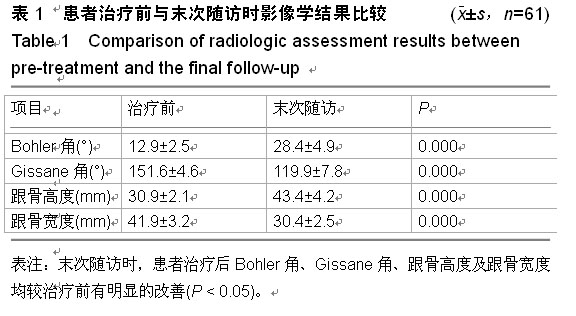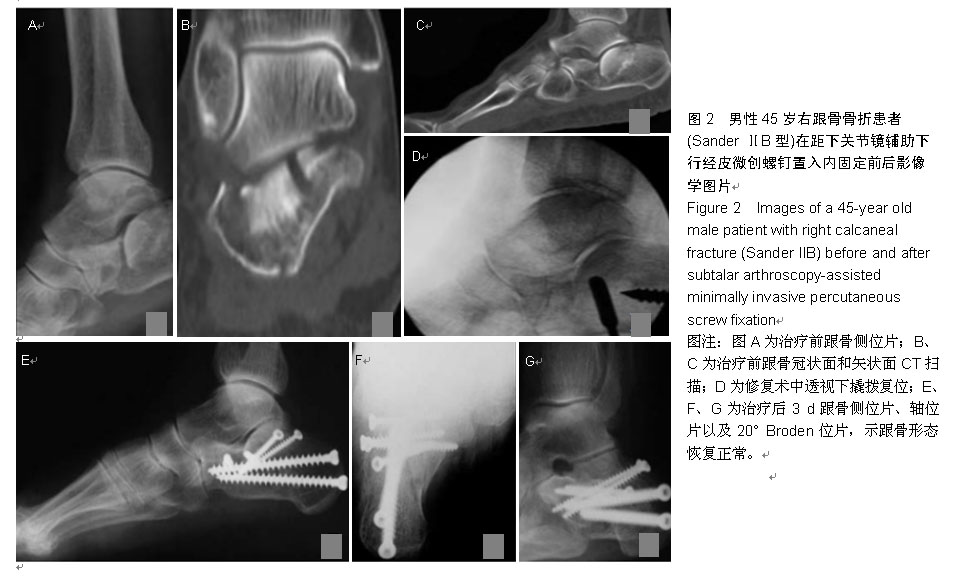| [1] Guerado E, Bertrand ML, Cano JR. Management of calcaneal fractures: what have we learnt over the years? Injury. 2012; 43(10):1640-1650.
[2] Barei DP, Bellabarba C, Sangeorzan BJ, Benirschke SK.Fractures of the calcaneus.Orthop Clin North Am. 2002; 33(1):263-285.
[3] Rammelt S, Amlang M, Barthel S, et al. Percutaneous treatment of less severe intraarticular calcaneal fractures.Clin Orthop Relat Res. 2010; 468(4):983-990.
[4] Rammelt S, Zwipp H. Calcaneus fractures: facts, controversies and recent developments. Injury. 2004; 35(5): 443-461.
[5] Sanders R. Displaced intra-articular fractures of the calcaneus. J Bone Joint Surg Am. 2000; 82(2):225-250.
[6] Bezes H, Massart P, Delvaux D, et al. The operative treatment of intraarticular calcaneal fractures: indications, technique, and results in 257 cases. Clin Orthop Relat Res. 1993; (290):55-59.
[7] Walde TA, Sauer B, Degreif J, et al. Closed reduction and percutaneous Kirschner wire fixation for the treatment of dislocated calcaneal fractures: surgical technique, complications, clinical and radiological results after 2-10 years. Arch Orthop Trauma Surg. 2008; 128(6):585-591.
[8] Zwipp H, Tscherne H, Thermann H,et al.Osteosynthesis of displaced intraarticular fractures of the calcaneus: results in 123 cases. Clin Orthop Relat Res.1993;(290):76-86.
[9] Abidi NA, Dhawan S, Gruen GS, et al. Wound-healing risk factors after open reduction and internal fixation of calcaneal fractures. Foot Ankle Int. 1998; 19(12):856-861.
[10] Harvey EJ, Grujic L, Early JS, et al. Morbidity associated with ORIF of intra-articular calcaneus fractures using a lateral approach. Foot Ankle Int. 2001; 22(11):868-873.
[11] Folk JW, Starr AJ, Early JS. Early wound complications of operative treatment of calcaneus fractures: analysis of 190 fractures. J Orthop Trauma. 1999; 13(5):369-372.
[12] Fernandez DL, Koella C. Combined percutaneous and minimal internal fixation for displaced articular fractures of the calcaneus. Clin Orthop Relat Res.1993;(290):108-116.
[13] Levine DS, Helfelt DL. An introduction to the minimally invasive osteosynthesis of intra-articular calcaneal fractures. Injury. 2001; 32(suppl 1):SA51-SA54.
[14] Gavlik JM, Rammelt S, Zwipp H. Percutaneous, arthroscopically-assisted osteosynthesis of calcaneus fractures. Arch Orthop Trauma Surg. 2002;122(8):424-428.
[15] Rammelt S, Gavlik JM, Barthel S, et al. The value of subtalar arthroscopy in the management of intra-articular calcaneus fractures. Foot Ankle Int. 2002; 23(10):906-916.
[16] Tornetta P 3rd. The Essex-Lopresti reduction for calcaneal fractures revisited. J Orthop Trauma.1998;12(7):469-473.
[17] Tornetta P 3rd. Percutaneous treatment of calcaneal fractures. Clin Orthop Relat Res. 2000; (375):91-96.
[18] Kitaoka H, Alexander I, Adelaar R, et al. Clinical rating system for the ankle, hindfoot, midfoot, hallux and lesser toes. Foot Ankle Int. 1994; 15(7):349-353.
[19] Ibrahim T, Beiri A, Azzabi M, et al. Reliability and validity of the subjective component of the American Orthopaedic Foot and Ankle Society clinical rating scales. J Foot Ankle Surg. 2007;46(2):65-74.
[20] Benirschke SK, Sangeorzan BJ. Extensive intraarticular fractures of the foot: surgical management of calcaneal fractures. Clin Orthop Relat Res. 1993; (292):128-134.
[21] Magnan B, Bortolazzi R, Marangon A, et al. External fixation for displaced intra-articular fractures of the calcaneum. J Bone Joint Surg Br. 2006; 88(11):1474-1479.
[22] McGarvey WC, Burris MW, Clanton TO, et al. Calcaneal fractures: indirect reduction and external fixation. Foot Ankle Int. 2006; 27(7):494-499.
[23] Schepers T, Vogels LM, Schipper IB, et al. Percutaneous reduction and fixation of intraarticular calcaneal fractures. Oper Orthop Traumatol. 2008; 20(2):168-175.
[24] Stulik J, Stehlik J, Rysavy M, et al. Minimally-invasive treatment of intra-articular fractures of the calcaneum. J Bone Joint Surg Br. 2006; 88(12):1634-1641.
[25] Battaglia A, Catania P, Gumina S, et al. Early minimally invasive percutaneous fixation of displaced intra-articular calcaneal fractures with a percutaneous angle stable device. J Foot Ankle Surg. 2015; 54(1):51-56.
[26] Crosby LA, Fitzgibbons T. Intraarticular calcaneal fractures: results of closed treatment. Clin Orthop Relat Res.1993; (290):47-54.
[27] Rammelt S, Amlang M, Barthel S, et al. Minimally-invasive treatment of calcaneal fractures. Injury. 2004; 35(Suppl 2): SB55-SB63.
[28] Buch J. Bohrdrahtosteosynthese des Fersenbeinbruches. Akt Chir. 1980; (15):285-296.
[29] 杜玉喜,刘年喜,牛智慧,等.解剖型接骨板内固定治疗跟骨关节内骨折[J].实用骨科杂志,2014,20(6):563-564.
[30] 张青山,张蜀华.两种手术治疗Sanders Ⅱ型、Ⅲ型跟骨骨折的比较[J].实用骨科杂志,2014,20(6):515-519.
[31] 刘光磊,张波涛,王峥,等.梯形切口治疗跟骨关节内骨折手术技巧及优点[J].实用骨科杂志,2014,20(3):283-284.
[32] 陈兵乾,盛晓文,薛峰,等.外侧"L"形切口锁定接骨板治疗跟骨骨折[J].实用骨科杂志,2014,20(3):273-275.
[33] 李金生,谢学义,徐剑锋,等.外侧低位切口手术治疗跟骨关节内骨折[J].实用骨科杂志,2014,20(5):458-460,461.
[34] 王震.小切口与“L”型切口治疗跟骨骨折疗效及并发症的对比研究[J].中国矫形外科杂志,2013,21(14):1402-1405.
[35] Griffin D, Parsons N, Shaw E, et al. Operative versus non-operative treatment for closed, displaced, intra-articular fractures of the calcaneus: randomised controlled trial. BMJ. 2014; 349: g4483.
[36] Nouraei MH, Moosa FM. Operative compared to non-operative treatment of displaced intra-articular calcaneal fractures. J Res Med Sci. 2011; 16(8):1014-1019.
[37] Bruce J, Sutherland A. Surgical versus conservative interventions for displaced intra-articular calcaneal fractures. Cochrane Database Syst Rev. 2013; 1: CD008628.
[38] Sanders R, Fortin P, DiPasquale T, et al. Operative treatment in 120 displaced intraarticular calcaneal fractures: results using a prognostic computed tomography scan classification. Clin Orthop Relat Res.1993; (290):87-95.
[39] 于涛,杨云峰,俞光荣.微创技术在治疗跟骨骨折中的应用进展[J].中国修复重建外科杂志,2013,27(2):236-239.
[40] 陈欣,姜宏.跟骨复位器配合克氏针撬拨治疗SandersⅡ型跟骨骨折46例[J].实用骨科杂志,2014,20(7):657-659. |


.jpg)